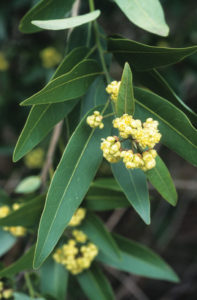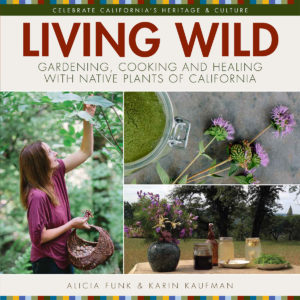Bay
LAUREL FAMILY
California Bay Umbellularia californica
Other Names Oregon Myrtle, Pepperwood, California Bay Laurel
Habitat & Elevation Hillsides, near streams, upper foothill and mixed conifer belts, and moist canyons below 5,000′
Collection Leaf: all seasons; Fruit: fall (purplish-brown in color when ripe)
Indigenous Names Nisenan sowdasim c’a, Bay nut sojba, Konkow sojba
![]()
California Bay Umbellularia californica
Plant type Evergreen tree or shrub
Size 25’x25′
Light Full sun to partial shade
Water Drought tolerant to moderate
Zone 7 to 10
In the wild, California Bay will grow into a dense shrub in dry settings or a 75′ – 100′ tall and wide tree when growing along creeks or in moist forests. In the garden, it grows slowly to 25′.[16, 23] It bears leathery, deep yellow-green, 2″ – 5″ long leaves that are pointed at both ends. The leaves are highly aromatic when crushed. Clusters of tiny pale-yellow flowers emerge in the early spring and give way to 1″ fruits that look like olives.
Plant in full sun to partial shade in fertile, well-drained soil and give moderate water until established. California Bay works well as a screen, background planting or clipped hedge. It can also grow into a specimen tree. It is highly adaptable with few pest or disease problems.[18]
![]()
Bay Nut Chocolate Clusters
- Collect California Bay nuts in fall
- 1 cup Bay nuts
- 1 bar organic dark chocolate
METHOD
- Preheat oven to 350o.
- Place unshelled nuts on a cookie sheet and bake for approximately 35 minutes.
- Shell and chop nuts.
- Melt chocolate in a double boiler.
- Add chopped nuts and mix well.
- Place spoonfuls of the chocolate nut mixture on a dish lined with wax paper.
- Set in freezer for about 15 minutes.[30]
TIP When nut-like fruit is ripe, it appears purplish-brown in color, feels hard, and appears smaller than in previous months. Remove and discard the outer “olive” portion of the nut. Nuts can also be eaten raw.[48]
VARIATIONS After roasting nuts, grind with sugar and cocoa powder to create a delicious chocolate-like dessert.
![]()
Headaches
Inhale crushed leaves, fresh or dried, according to the Chippewa Indians.[5, 2]
Household Cleaner and Disinfectant
For a disinfectant and surface cleaning spray, cover leaves
with hot water and let steep for 2 hours to overnight. When cool, strain and transfer liquid to a spray bottle and use for up to 3 months. Maidu Indians dried and burned the leaves to keep bugs away.[48]
Poison Oak
Make a tea for external use with 5 leaves per cup of water. Rinse infected areas immediately and apply as needed.
Purification and Ceremony
The Maidu Indians hung a flag of Bay, Cedar, Willow and Mugwort in each of the four directions prior to the start of a ceremony.[48]
Rheumatism, Sore Muscles, Joint Inflammation
Make a tea for external use, with 5 leaves per cup of water. Strain and add to bath.
![]()
Furniture
The Maidu Indians used Umbellularia californica as a preferred wood for furniture.[48] Local artists also use Cedar, Fir, Madrone, Manzanita, Maple, Oak and Ponderosa Pine for hand-crafted wood pieces.[75, 76]
Waterproofing
Gather nuts of Umbellularia californica. Remove husks and set nuts aside for food uses. Mash husks, cover with water, and bring to a light boil. To waterproof, dip entire item quickly in and out of the hot water. To keep for future use, scoop off the foamy oil with 2 flat sticks and roll it into a ball. Let cool. Break off pieces as needed and use for waterproofing, according to Maidu Indian tradition.[48]





